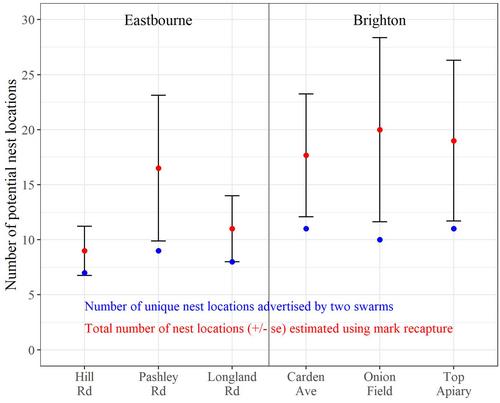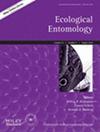Do nest sites limit wild honey bee colonies? Decoding swarm waggle dances to assess nest site availability
IF 1.6
3区 农林科学
Q2 ENTOMOLOGY
引用次数: 0
Abstract


巢址会限制野生蜜蜂群吗?解码蜂群摇摆舞以评估巢址可用性
在野生蜂群密度较低(平均 0.26/km2)的欧洲,巢址通常被认为是限制野生蜜蜂蜂群的因素。巢址的可用性很难直接量化,特别是在城市地区和农田中,蜂群在不同的基质中筑巢。在这里,我们通过解码 3310 个侦察员在蜂群中产生的摇摆舞来间接评估大面积(78.5 平方公里)混合栖息地(67% 农田、25% 城市和 8% 林地)的巢址可用性。2021 年和 2022 年夏季,在英格兰东萨塞克斯郡的两个研究区域内设置了 14 个人工蜂群。蜂群在舞蹈开始后的0.4-15.2个白天内(中位数为2.7个小时),在0.1-11.2千米(中位数为1.2千米)的距离内宣传了3-9个巢穴位置(平均为5.5个)。我们通过量化两个蜂群广告位置的重叠(一种标记重捕)来估算巢穴位置的总数,包括未做广告的位置,得出的平均密度约为每平方公里三个巢穴。通过模拟舞蹈变化计算出的每平方公里蜂群宣传巢址的概率,与随机期望值相比,城市地区(0.018/平方公里)平均高出42%,林地(0.023/平方公里)高出78%,农田(0.011/平方公里)低12%。在控制了距离之后,蜂群在林地宣传巢址的可能性仍然高于预期,但这只发生在一个研究区域。我们的结果表明,鉴于我们对巢穴密度的保守估计(3个/平方公里)超过了附近陆地庄园的野生群落密度(2个/平方公里)和欧洲其他地方的野生群落密度(0.26个/平方公里),巢穴并没有限制研究地区的野生群落。
本文章由计算机程序翻译,如有差异,请以英文原文为准。
求助全文
约1分钟内获得全文
求助全文
来源期刊

Ecological Entomology
生物-昆虫学
CiteScore
4.90
自引率
4.50%
发文量
94
审稿时长
3 months
期刊介绍:
Ecological Entomology publishes top-quality original research on the ecology of insects and related invertebrate taxa. Our aim is to publish papers that will be of considerable interest to the wide community of ecologists who are motivated by ecological or evolutionary theory. The suitability of a manuscript will usually be assessed within 5 days.
We publish full-length Original Articles as well as Reviews, Short Communications, Methods and Natural History papers. In Original Articles, we greatly prefer papers that test specific hypotheses and which have a high degree of novelty. All categories aim for innovative contributions that advance the subject of ecological entomology.
 求助内容:
求助内容: 应助结果提醒方式:
应助结果提醒方式:


